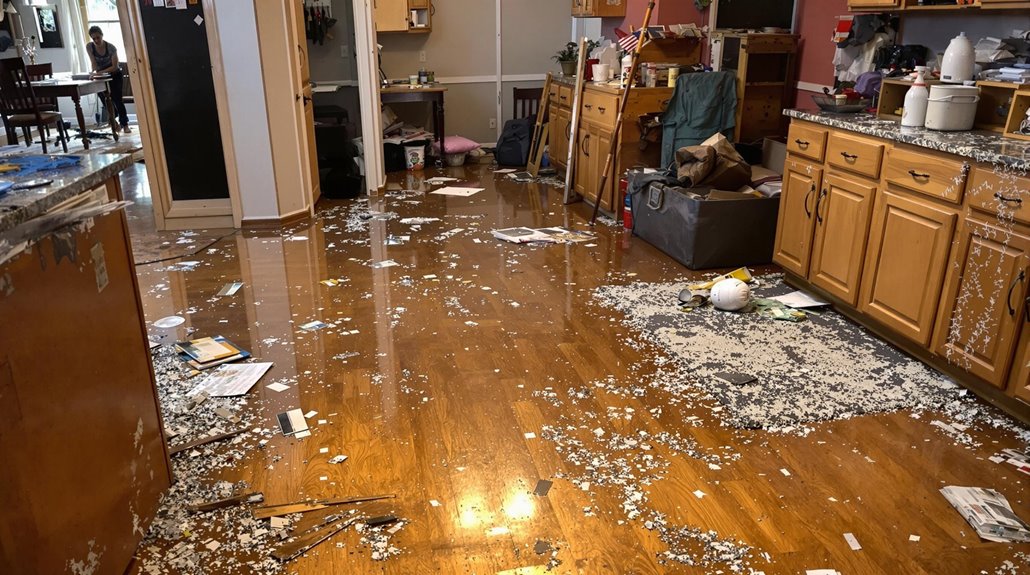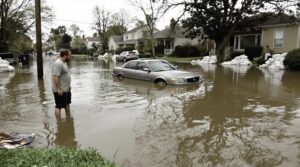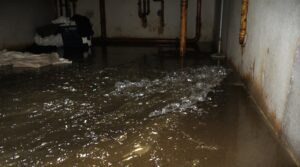Flood damage insurance claims involve multiple steps, requiring prompt initiation and thorough documentation to guarantee fair payouts for policyholders. To initiate a claim, policyholders must notify their insurance provider within 60 days of the flood event and submit a Proof of Loss form. An insurance adjuster will assess the damage and prepare a detailed report outlining the extent of the loss. Understanding the claims process and factors affecting payouts can help policyholders navigate the complex process and achieve a successful outcome, with further guidance available to facilitate a smoother experience.
Key Takeaways
- Notify your insurance provider within 60 days of the flood event to initiate the claims process.
- Document all damages with clear photographs and videos to support your claim and facilitate assessment.
- The insurance adjuster conducts on-site inspections to assess flood damage and prepare detailed reports outlining damage assessment.
- Claim payouts are influenced by policy type, deductible amount, policy limits, depreciation, and replacement cost value policies.
- Thorough documentation, including a detailed inventory and repair estimates, is crucial for a smooth claims process and expedited settlement.
How To Initiate A Flood Damage Insurance Claim
When a flood event occurs, it is essential to initiate the insurance claim process in a timely manner to guarantee a smooth and efficient recovery.
To initiate a flood damage insurance claim, policyholders must promptly notify their insurance provider, ideally within 60 days of the flood event. A completed Proof of Loss form, along with detailed documentation, including insurance policy details, photographs, and videos of damaged areas and items, is required to formally initiate the claim process.
An insurance adjuster will assess the damage on-site, requiring access to affected areas and additional documentation. Policyholders should maintain detailed records of all communications with the insurance company and receipts for repairs or mitigation efforts.
This thorough documentation facilitates a complete claim assessment, ensuring a fair and efficient claim process.
Steps To Take Before Filing A Flood Insurance Claim
Numerous steps must be taken before filing a flood insurance claim to guarantee a smooth and efficient process. To initiate the claims process, policyholders must notify their insurance provider promptly, ideally within 60 days of the flood. Documenting all damages thoroughly is essential, as it provides evidence for the claim. This includes taking clear photos and videos of affected areas and creating an extensive inventory list of damaged items. In addition to documenting damages, policyholders should save all receipts related to repairs and temporary living expenses, as these can also strengthen the claim. It’s also advisable to keep a record of all communications with the insurance company for reference. For those navigating this process for the first time, seeking out flood damage insurance claim tips can further assist in maximizing potential reimbursements and minimizing stress during this challenging time.
| Pre-Filing Steps | Purpose | Recommended Timeframe |
|---|---|---|
| Notify insurance provider | Initiate claims process | Within 60 days |
| Document all damages | Provide evidence for claim | As soon as possible |
| Separate damaged items | Streamline assessment process | Ongoing |
| Mitigate your damages | Prevent further damage | Immediately |
Documenting Damage To Maximize Flood Insurance Payouts

Documenting damage is a critical step in the flood insurance claims process, as it provides visual and factual evidence to support the claim amount.
To effectively document damage, policyholders should take clear photographs and videos of all damaged areas and items, as well as create a detailed inventory list with estimated values and receipts.
Additionally, any mitigation efforts, such as water removal or mold prevention, should be documented to demonstrate proactive measures to minimize further damage.
Organizing all documentation systematically will facilitate a smoother claims process and expedite assessment by the claims adjuster.
This thorough documentation enables the insurance company to conduct a more accurate flood damage assessment, ultimately influencing the claim payout.
Accurate documentation is essential for a successful claims process.
Working with a public insurance adjuster can help maximize settlement amounts by ensuring all damage is properly documented and valued according to policy terms.
Understanding The Role Of An Insurance Adjuster In Flood Damage Claims
Insurance adjusters play an essential role in the flood damage claims process, serving as impartial evaluators of the extent of losses incurred by policyholders. Their primary responsibility is to conduct on-site inspections, gather relevant information, and assess flood damage accurately.
Utilizing specialized tools, such as moisture meters, they measure water damage levels and document findings through photographs and videos. Adjusters then prepare detailed reports outlining their assessment, which determines the claim payout based on policy terms and coverage limits.
Effective communication with policyholders is vital, as adjusters may request additional documentation to guarantee a thorough evaluation. The adjuster's findings greatly influence the final settlement amount, emphasizing the importance of policyholder engagement and presentation of relevant damage evidence.
With an average annual salary of $61,465, insurance adjusters must balance analytical expertise with interpersonal skills while managing these complex flood-related claims.
Determining The Extent Of Loss In Flood Damage Insurance Claims

Following the insurance adjuster's assessment, the next step in the flood damage claims process involves determining the extent of loss incurred by the policyholder. This determination is critical in calculating the flood insurance claim payout.
The adjuster's report outlines the damage's severity and influences the insurer's settlement decision. To determine the extent of loss, the adjuster evaluates the property and documents all damages, taking into account the policy's coverage limits and deductibles.
The assessment may be based on Actual Cash Value (ACV), which considers depreciation, or Replacement Cost Value (RCV), which focuses on the cost to replace items without depreciation.
The adjuster's findings are then used to calculate the claim payout, ensuring that the policyholder receives fair compensation for the damages incurred.
Public insurance adjusters can provide expert assistance in navigating complex flood damage claims to ensure fair compensation for property owners.
Factors That Affect Flood Insurance Claim Payout Amounts
A policyholder's flood insurance claim payout amount is influenced by various factors, which play a notable role in determining the final compensation received.
The type of flood insurance policy, deductible amount, and policy limits notably impact the payout process. Insurers also consider the depreciation of items when calculating actual cash value payouts, which can result in lower compensation for older or pre-owned belongings.
The following factors affect flood insurance claim payout amounts:
- Type of Policy: Actual cash value policies account for depreciation, while replacement cost value policies provide full reimbursement for replacement without depreciation deductions.
- Deductible Amount: Higher deductibles reduce the payout amount, as policyholders are responsible for paying the deductible before insurance coverage kicks in.
- Policy Limits: Policy limits dictate the maximum amount that can be claimed, even if damages exceed this limit.
How To Evaluate And Negotiate A Flood Insurance Claim Settlement

Numerous factors contribute to a successful flood insurance claim settlement negotiation, and understanding these elements can greatly impact the final compensation amount received.
When evaluating a settlement, policyholders must document all damages thoroughly, including photographs and detailed inventories of affected items, to provide strong evidence during negotiations with the insurance adjuster.
Gathering multiple repair estimates also helps to understand the true cost of repairs, ensuring the claim reflects accurate expenses.
Reviewing insurance policy coverage, limits, and deductibles is also vital in determining the settlement amount.
Effective communication with insurance companies is essential in negotiating flood claims.
By presenting thorough documentation and robust evidence, policyholders can maximize their settlement amount and receive fair compensation.
Accurate preparation is key to a successful negotiation.
Working with a public adjuster can help navigate complex policy terms and improve the likelihood of receiving maximum compensation for flood-related damages.
The Payout Process For Flood Damage Insurance Claims
The payout process for flood damage insurance claims is complex and multifaceted, involving a series of steps that ultimately lead to the release of funds for policyholders to undertake repairs or replacements. Following the adjuster's assessment, the insurance company reviews the findings to make a determination regarding coverage and settlement.
Key Components of the Payout Process:
- Initial Payout: Typically reflects the actual cash value (ACV) of damaged items, accounting for depreciation.
- Multiple Payments: Separate checks may be issued for structural damage, personal property, and Additional Living Expenses (ALE) if the home is uninhabitable.
- Mortgage Lender Endorsement: Required for payout checks, ensuring protection of their financial interest.
Tips For Expedited Flood Damage Insurance Claim Settlements

When maneuvering the complexities of flood damage insurance claims, policyholders can take proactive steps to expedite the settlement process. Notifying the insurance provider within 60 days of the flood is vital to initiate the claims process in a timely manner.
Policyholders should also document all damage through thorough photos and videos, maintaining a detailed inventory of affected items and their values. Estimated repair costs should be obtained through multiple repair estimates to provide a clear picture of the costs involved.
Resolving Disputes And Appealing Flood Insurance Claim Decisions
Disputes arising from flood insurance claim settlements can be resolved through a structured appeals process, allowing policyholders to contest decisions they deem unfair or inaccurate.
Policyholders should first review their policy to understand the procedures for appealing a claim decision. If the insurance company's decision is disputed, policyholders can appeal the decision by gathering additional evidence and submitting a written appeal within the specified timeframe.
The following steps can facilitate a successful appeal:
- Understand the flood insurance policy: Review policy terms, coverage limits, and exclusions to guarantee a thorough understanding of the flood insurance coverage.
- Document all communications: Retain copies of correspondence with the insurer to strengthen the position during the appeals process.
- Seek professional guidance: Consider hiring legal representation or a public adjuster if the appeal is denied or if negotiations with the insurer are unsuccessful.








